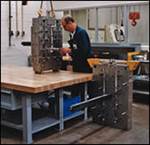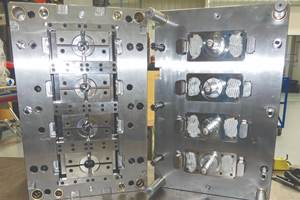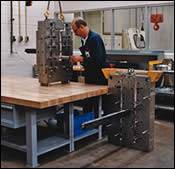Skill Sets for Mold Repair
The skills requirements of mold building versus mold repair.
There does not seem to be a clear and reasonable distinction between moldmaking and mold repair. Applicants for in-house mold repair shops are quizzed about their moldmaking experience with the obligatory “Do you have any experience doing repair work?” question tagged on.
Though mold building and mold repair employ some of the same basic skills, they are two separate and distinct job classifications. Following are just two factors that contribute to the lack of clear distinction.
1. Molds being one-off and unique cannot by virtue of scale support the specialties required to deal with ongoing issues during the useful life of a tool. If molds were as numerous as cars there would be separate classes of technicians to deal with gating issues, cooling issues, cavity damage, mold action problems (with a sub-category of specialist to deal with hydraulic actions) and hot runner specialists.
Obviously there are isolated individuals who specialize in each of these areas and they provide an invaluable service to the molding industry. The problem is that not every molder has ready access to these specialists. Though the requisite specialties cannot be supported by virtue of scale, molders must by virtue of necessity staff their in-house repair shops with people they hope turn out to be multi-specialists.
2. Economic investment. A mold builder has to make significant investments in software and machine tools—the cost of which can be distributed over many molds. In contrast, most mold repairs do not require engineering software and expensive machine tools, and the relatively few times such equipment is required makes it difficult to justify the investment. So, those types of repairs by default remain largely the responsibility of the mold builder.
It’s probably safe to say that most mold builders do repairs to keep customers happy rather than any real desire to be involved in that line of work. It’s never convenient to break into a shop schedule to expedite an urgent repair.
Repair Skills
If moldmaking and mold repair are indeed two separate entities the question becomes “What are the specific skill sets required for a mold repair technician?” Unfortunately the answer may be largely influenced by the specific repair environment. That is to say, if the in-house toolroom is fully equipped, the level of repairs may be quite a bit more complex than those performed in a bare-bones, band-aid shop.
If the molder has a specialty (i.e. automotive, medical, consumer products, etc.), the repair expectations may be entirely different and so too the attendant skills needed to accomplish them.
Repair Defined
One last major issue to wrestle with is the definition of repair. A repair can be anything from replacing a broken water line to troubleshooting an electrical problem to re-qualifying a damaged cavity.
All caveats considered, let’s agree to be specifically general (oxymoron intended): specific in regards to the distinction between building and repairing; and, general in regards to the variety of environments likely to require repair technicians.
When speaking of skills almost by default, hard skills are the first to come to mind. These hard skills are those that overlap with mold building. In at least some measure, machining skills are required of a repair technician—at a very minimum, a fairly high degree of facility with the basic machine tools: lathe, mill and grinder. Even in environments with minimal repair expectations, replacing ejector pins, remaking damaged core pins and removing galled tooling are functions that require the use of manual machine tools. In the world of molds, the word welding is almost synonymous with repair. A technician with excellent welding skills is a rare find.
Other skills would include familiarity with measuring tools and practices, the understanding of mechanical functions—specifically the functions of mold actions, a basic comprehension of how molds operate and the need for draft and shrink. Math (trig) skills are high on the list and print reading/sketching skills are also very helpful.
A repair tech needs to be able to do the routine remove-and-replace repairs that entail swapping out worn or damaged components, yet some of the more valuable skills are on the soft end of the scale.
Ability to do root cause analysis—to provide best practices information for improvements in future builds.
Trouble-shooting skills—the systematic elimination of possible causes from simple and easy to complex and difficult.
Diagnostic skills—the ability to read the evidence on the mold surfaces; to judge the shutoffs, gas trails, resin build-up, PL hobs, gate strings etc.
Knowledge base—how plastic flows, conditions that cause flash, gating requirements, venting requirements, temperatures and pressures involved in the molding process and how these affect and are affected by mold design and condition (search: forensic polymer engineering and rheology for more information).
These are the types of skills that are developed over time by individuals that are motivated by passion more than a paycheck. People whose normal practice is to analyze situations, compare results, build on experience and brainstorm innovative solutions. In the end, it’s solutions that matter, the requisite skills come full circle where the soft informs the hard and together they produce a repair that gets the mold back in the press doing what it was designed to do.
Summary
Breakdowns and damage are an inevitable part of molding, while in-house repair facilities are understaffed and insufficiently equipped, and time is the ultimate enemy. These are the challenges. The prized skills of a mold repair tech are an informed determination and unwavering tenacity. The determination to rise to the challenge and the tenacity to persist thru failures until the right repair is attained.
Related Content
How to Overcome Complex Mold Texturing Problems
Key benefits when considering laser technology for mold texturing and repair.
Read MorePrecision Welding Services Offer Rapid Turnaround Mold Repair and Reduced Molder Downtime
X-Cell Tool & Mold relies on outsourced, high-quality welding repairs from Lewis-Bawol Welding to ensure its customers' molds are back in production quickly and affordably.
Read MoreWhat is Scientific Maintenance? Part 2
Part two of this three-part series explains specific data that toolrooms must collect, analyze and use to truly advance to a scientific maintenance culture where you can measure real data and drive decisions.
Read MoreThink Safety: Eliminate Hazards Throughout the Shop
The tooling community is taking advantage of new products for safer mold shops and molding facilities.
Read MoreRead Next
Evaluating Mold Repair Skills
A systematic approach to train mold repair skills is more effective.
Read MoreHow to Use Continuing Education to Remain Competitive in Moldmaking
Continued training helps moldmakers make tooling decisions and properly use the latest cutting tool to efficiently machine high-quality molds.
Read MoreHow to Use Strategic Planning Tools, Data to Manage the Human Side of Business
Q&A with Marion Wells, MMT EAB member and founder of Human Asset Management.
Read More


















